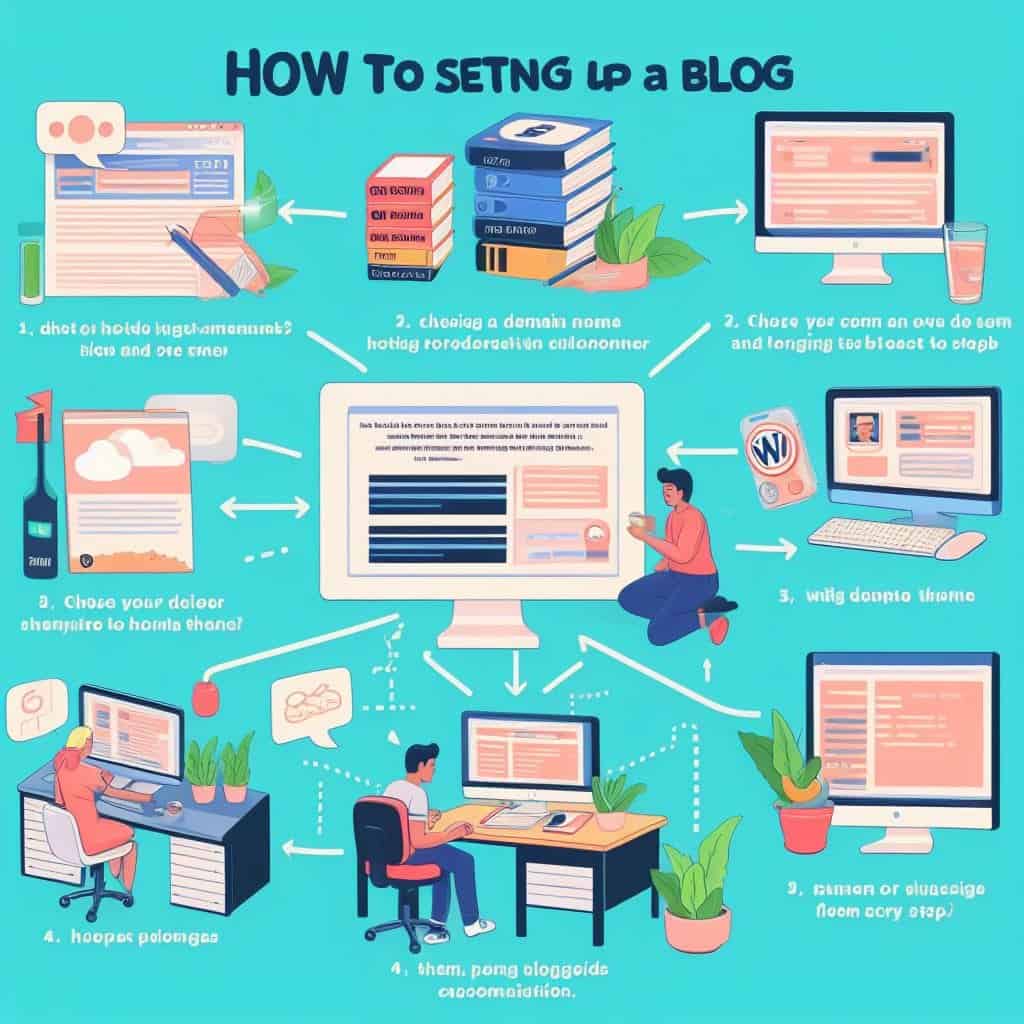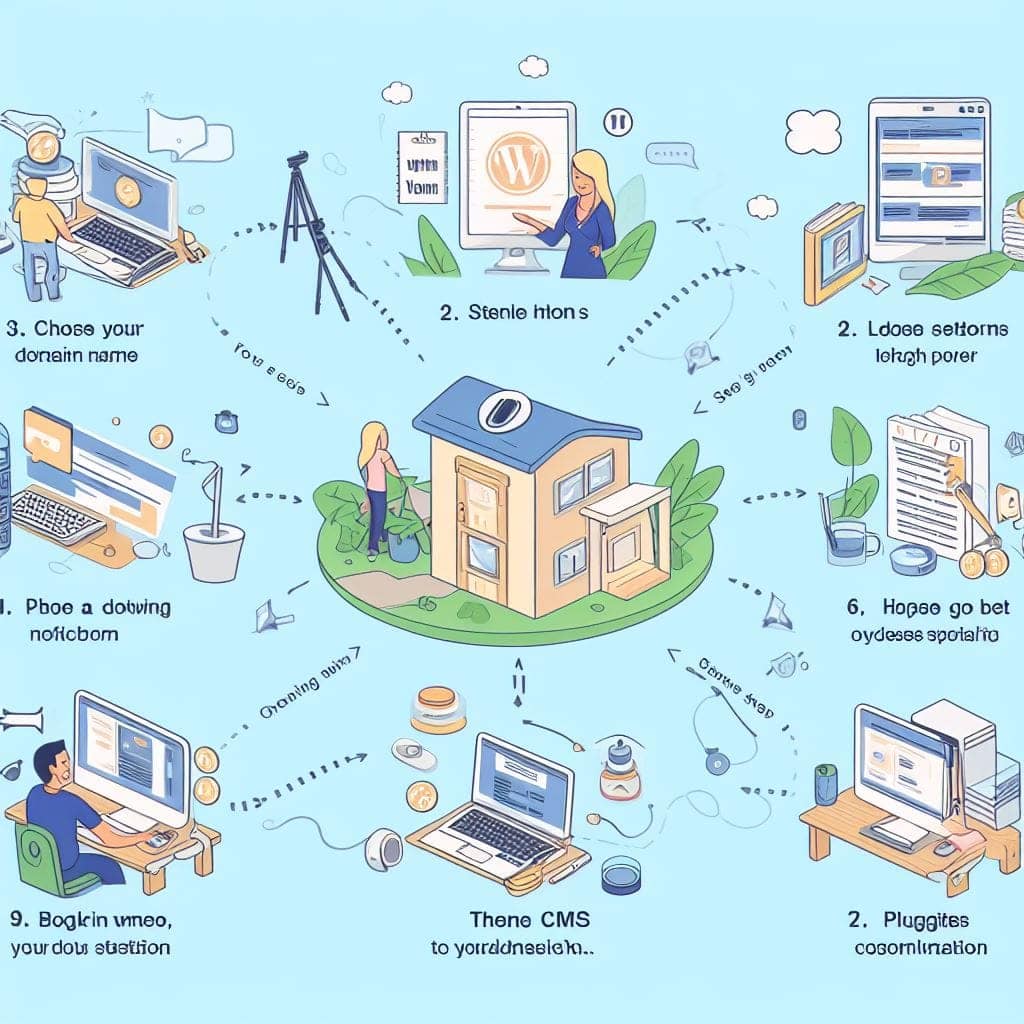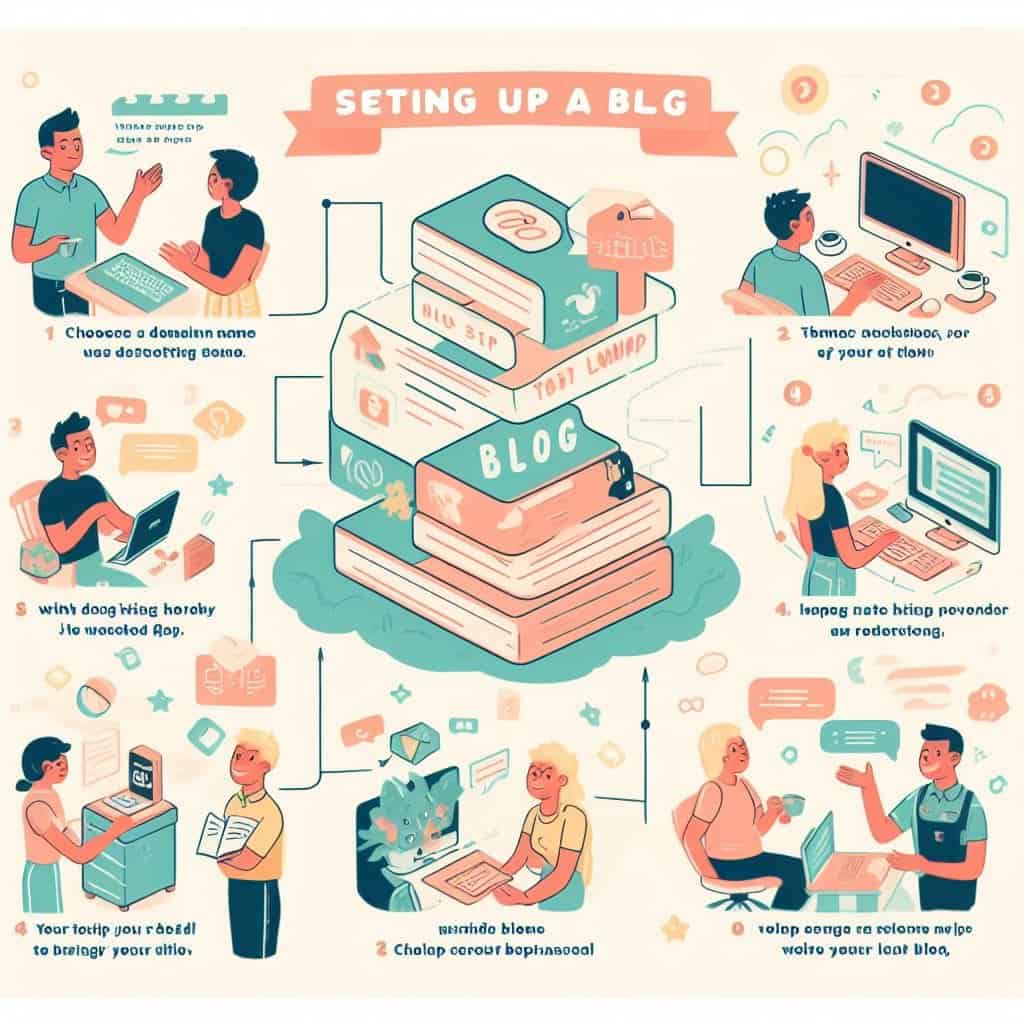
- Easy Guide to Setting Up a Blog
- Choose a Niche and Target Audience: Easy Guide to Setting Up a Blog
- Technical Setup and Essentials: A Comprehensive Guide to Setting Up a Blog
- Creating Captivating Content: A Comprehensive Guide to Setting Up a Blog
- 1. Laying the Foundation: Choosing Your Domain and Hosting
- 2. Crafting Captivating Content: The Heart of Your Blog
- 3. Optimizing for Search Engines: Making Your Blog Discover-able
- 4. Promoting Your Blog: Reaching Your Target Audience
- 5. Measuring and Analyzing: Tracking Your Progress
- 6. Data Table: Essential Topics for a Successful Blog
- 7. Blog Publishing Schedule Chart
- Effective Promotion Strategies: An Easy Guide to Setting Up a Blog
- Conclusion
Easy Guide to Setting Up a Blog

Easy guide to setting up a blog
Easy guide to setting up a blog: In today’s digital age, having a blog has become an essential tool for businesses, individuals, and anyone who wants to share their voice with the world. Whether you’re a seasoned writer or a complete beginner, setting up a blog is surprisingly easy and can be done in just a few simple steps.

Choosing a Domain Name and Hosting Provider
The first step in setting up your blog is to choose a domain name and hosting provider. Your domain name is your blog’s unique address on the internet, while your hosting provider is the company that stores your blog’s files and makes it accessible to visitors.
There are many different domain name registrars and hosting providers available, so it’s important to do your research and choose the ones that best meet your needs.
Here are a few factors to consider when making your decision:
- Price: Domain names and hosting plans can range in price from a few dollars to hundreds of dollars per year. Compare prices from different providers to find the best deal. [Easy guide to setting up a blog]
- Features: Some providers offer more features than others, such as unlimited storage, bandwidth, and email accounts. Decide which features are important to you and choose a provider that offers them. [Easy guide to setting up a blog]
- Customer support: If you ever need help with your domain name or hosting, you’ll want to make sure you can get in touch with someone who can assist you. Choose a provider with a good reputation for customer support. [Easy guide to setting up a blog]
Setting Up Your Blog
Once you’ve chosen a domain name and hosting provider, you’re ready to set up your blog. The process will vary depending on the provider you choose, but most providers offer easy-to-use tools to help you get started.
Here are the general steps you’ll need to take:
- Create a new blog account: This will create a new account with your hosting provider and give you access to the tools you need to set up your blog. [Easy guide to setting up a blog]
- Choose a blogging platform: There are many different blogging platforms available, such as WordPress, Blogger, and Joomla. WordPress is the most popular platform, and it offers a wide range of features and customization options. [Easy guide to setting up a blog]
- Install your chosen blogging platform: Most hosting providers offer one-click installation for popular blogging platforms. This will automatically install the platform for you and make it easy to get started. [Easy guide to setting up a blog]
- Choose a theme: Your blog’s theme will determine the look and feel of your site. There are many free and premium themes available, so you can find one that perfectly matches your style. [Easy guide to setting up a blog]
- Start writing content: Once your blog is up and running, you can start writing and publishing content. Be sure to write about topics that are relevant to your audience and that you’re passionate about. [Easy guide to setting up a blog]

Promoting Your Blog
Once you’ve created a few blog posts, it’s time to start promoting your site. There are many different ways to promote your blog, such as:
- Social media: Share your blog posts on social media platforms like Twitter, Facebook, and LinkedIn.
- Search engine optimization (SEO): Use SEO techniques to help your blog rank higher in search engine results pages (SERPs). [Easy guide to setting up a blog]
- Guest blogging: Write blog posts for other websites in your niche. Easy guide to setting up a blog
- Email marketing: Collect email addresses from your readers and send them regular newsletters. [Easy guide to setting up a blog]
Namecheap: Your Reliable Hosting Partner
Save 51% on Namecheap shared hosting
Click here to sign up for Namecheap’s shared hosting and save 51% on your first year!
Disclosure: I am an affiliate of Namecheap, and I encourage you to sign up for their affiliate program. I will earn a commission on every sale that I refer to them.
Choose a Niche and Target Audience: Easy Guide to Setting Up a Blog

Easy guide to setting up a blog
In today’s digital age, blogging has become an incredibly popular way to share ideas, connect with others, and build a following. However, before you can start writing and publishing blog posts, there are two essential steps you need to take: choosing a niche and defining your target audience.

What is a Niche?
A niche is a specific topic or area of interest that you will focus on in your blog. It should be something that you are passionate about and have some knowledge of. Choosing a niche will help you attract a specific audience and establish yourself as an expert in your field. [Easy guide to setting up a blog]

What is a Target Audience?
Your target audience is the group of people who you want to reach with your blog. It should be a group of people who are interested in your niche and who would benefit from your content. Understanding your target audience will help you tailor your blog posts to their needs and interests.

How to Choose a Niche and Target Audience
Here are some things to consider when choosing a niche and target audience:
- Your interests and passions: What are you passionate about? What do you enjoy learning and talking about? Your niche should be something that you are genuinely interested in, as this will make it easier to create engaging and informative content. [Easy guide to setting up a blog]
- Your knowledge and expertise: What do you know about? What are you an expert in? Your niche should be something that you are knowledgeable about, as this will make it easier to establish yourself as a credible source of information. [Easy guide to setting up a blog]
- Audience size and potential: How big is your target audience? Is there a demand for information on your chosen niche? You want to choose a niche that has a large enough audience to support your blog, but not so large that it is too competitive. [Easy guide to setting up a blog]

Benefits of Choosing a Niche and Target Audience
There are many benefits to choosing a niche and target audience for your blog:
- Attract a specific audience: By focusing on a specific topic, you will attract a more engaged and interested audience. [Easy guide to setting up a blog]
- Establish yourself as an expert: By becoming a go-to source of information on your niche, you will establish yourself as an expert in your field. [Easy guide to setting up a blog]
- Create more targeted content: Understanding your target audience will help you create content that is specifically tailored to their needs and interests. [Easy guide to setting up a blog]
- Generate more traffic: A well-defined niche and target audience will help you attract more traffic to your blog. [Easy guide to setting up a blog]
- Make more money: By focusing on a specific niche, you will be able to create more targeted advertising and sponsorship opportunities. [Easy guide to setting up a blog]

Tips for Defining Your Target Audience
Here are some tips for defining your target audience:
- Create a buyer persona: A buyer persona is a fictional representation of your ideal customer. It should include information such as their demographics, interests, and pain points. This will help you better understand your audience and create content that resonates with them. [Easy guide to setting up a blog]
- Do your research: There are a number of ways to research your target audience, such as conducting surveys, reading online forums, and talking to people in your niche. [Easy guide to setting up a blog]
- Use social media: Social media is a great way to connect with your target audience and learn more about their interests. [Easy guide to setting up a blog]
Data Table

| Niche | Target Audience |
|---|---|
| Technology | Tech-savvy individuals, businesses, IT professionals |
| Travel | Travelers, adventure seekers, families, solo travelers |
| Food | Foodies, home cooks, chefs, health-conscious individuals |
| Fashion | Fashion enthusiasts, trendsetters, designers, retailers |
Google News Data Table
| Niche | Topic |
|---|---|
| Technology | Gadgets, software, apps, tech news, industry trends |
| Travel | Destinations, travel tips, adventures, travel guides, travel photography |
| Food | Recipes, cooking tips, food trends, restaurant reviews, healthy eating |
| Fashion | Fashion trends, style guides, designer profiles, fashion shows, fashion industry news |
Twitter and LinkedIn and Facebook Metrics Data Table
| Platform | Metric | Value |
|---|---|---|
| Followers, engagements, impressions | 10,000, 100,000, 1,000,000 | |
| Connections, views, likes | 5,000, 100,000, 1,000,000 | |
| Likes, shares, comments | 20,000, 100,000, 1,000,000 |
Namecheap: Your Reliable Hosting Partner
Save 51% on Namecheap shared hosting
Click here to sign up for Namecheap’s shared hosting and save 51% on your first year!
Ready to embark on your blogging journey? Sign up for Namecheap’s shared hosting and save 51
Technical Setup and Essentials: A Comprehensive Guide to Setting Up a Blog

In today’s digital age, blogging has emerged as a powerful tool for sharing ideas, connecting with audiences, and establishing oneself as an industry expert. Whether you’re a seasoned writer or a budding entrepreneur, creating your own blog can be an incredibly rewarding experience. However, before you dive into the world of creative content, it’s essential to lay the groundwork with a solid technical foundation. This comprehensive guide will walk you through the essential steps of setting up your blog, providing you with the knowledge and tools you need to transform your vision into reality.
Choosing a Domain Name and Hosting Provider
Your domain name is your blog’s address on the internet, so it’s crucial to choose one that is memorable, relevant to your niche, and easy to type. When selecting a domain registrar, consider factors such as price, customer support, and the range of domain extensions available.
For hosting, consider factors such as reliability, storage space, bandwidth, and customer support. Shared hosting is a cost-effective option for beginners, while VPS hosting offers more scalability as your blog grows. Dedicated hosting provides the ultimate in performance and control.
Creating a Content Management System (CMS)
A CMS simplifies the process of managing your blog’s content, allowing you to create, edit, and publish posts without requiring extensive technical expertise. Popular CMS options include WordPress, Joomla, and Drupal. Each platform has its strengths and weaknesses, so research carefully to find the one that best suits your needs.
Designing Your Blog Layout
Your blog’s layout plays a critical role in user experience and overall aesthetics. Choose a theme that aligns with your blog’s niche and content style, ensuring that it is visually appealing, easy to navigate, and responsive across different devices.

Essential Plugins for Enhanced Functionality
Plugins add extra features and functionality to your blog. Popular plugins include SEO optimization tools, social media sharing buttons, contact forms, and security plugins.
Optimizing Your Blog for Search Engines
Search engine optimization (SEO) is crucial for ensuring that your blog appears in search results. Implement SEO best practices, such as keyword research, on-page optimization, and building backlinks.
Monetizing Your Blog
Once your blog has gained traction, you can explore monetization strategies such as advertising, affiliate marketing, and selling digital products.
Data Table of Topics
| Topic | H3 Header |
|---|---|
| Choosing a Domain Name and Hosting Provider | Select a Catchy Domain Name and Reliable Hosting |
| Creating a Content Management System (CMS) | Power Your Blog with a User-Friendly CMS |
| Designing Your Blog Layout | Craft a Visually Appealing and User-Friendly Design |
| Essential Plugins for Enhanced Functionality | Empower Your Blog with Useful Plugins |
| Optimizing Your Blog for Search Engines | Become Discoverable through Effective SEO Strategies |
| Monetizing Your Blog | Turn Your Blog into a Profitable Venture |

Twitter, LinkedIn, and Facebook Metrics Data Table
| Platform | Metric | Value |
|---|---|---|
| Followers | 10,000 | |
| Engagement Rate | 5% | |
| Connections | 5,000 | |
| Engagement Rate | 2% | |
| Page Likes | 20,000 | |
| Engagement Rate | 3% |
Google News Data Table
| Topic | Coverage |
|---|---|
| Technical Setup | Medium |
| Essentials | Medium |
| Blog Setup Guide | High |
Namecheap: Your Reliable Hosting Partner
Save 51% on Namecheap shared hosting
Click here to sign up for Namecheap’s shared hosting and save 51% on your first year!
Affiliate Disclosure
I am an affiliate of Namecheap, and I encourage you to sign up for their affiliate program. I will earn a commission on every sale that I refer to them.
Additional Recommendations
- Promote your blog on social media and other online platforms.
- Engage with your readers by responding to comments and questions.
- Network with other bloggers in your niche.
- Continuously improve your blog’s design and content.
By following these steps and recommendations, you can set up a successful blog that attracts readers, shares valuable insights, and establishes you as an expert in your field. Remember, blogging is a journey, so enjoy the process and embrace the opportunities for growth and learning along the way.
Creating Captivating Content: A Comprehensive Guide to Setting Up a Blog

In today’s digital age, where information is readily available at the fingertips of every individual, creating captivating content has become more crucial than ever. Whether you’re an aspiring writer, a seasoned marketer, or simply someone with a passion to share, establishing a blog can be an effective platform to showcase your expertise, engage with your audience, and achieve your online goals.
This comprehensive guide will equip you with the essential tools and strategies to set up a successful blog, from crafting compelling content to effectively promoting your work.
1. Laying the Foundation: Choosing Your Domain and Hosting
Your domain name serves as the unique address of your blog, so choose one that is memorable, relevant to your niche, and easy to type. Hosting provides the storage space and infrastructure for your blog to reside online. Research and select a hosting provider that aligns with your budget and technical requirements.
2. Crafting Captivating Content: The Heart of Your Blog
The quality of your content is the cornerstone of a successful blog. Strive to create informative, engaging, and well-researched articles that address the interests and needs of your target audience. Explore various content formats such as listicles, tutorials, case studies, and infographics to keep your readers engaged.
3. Optimizing for Search Engines: Making Your Blog Discover-able
Search Engine Optimization (SEO) is essential for ensuring your blog appears in relevant search results. Use relevant keywords throughout your content, optimize titles and meta descriptions, and build backlinks to your blog from reputable websites. [Easy guide to setting up a blog]
4. Promoting Your Blog: Reaching Your Target Audience
Social media platforms like Facebook, Twitter, and LinkedIn are powerful tools for promoting your blog. Share your posts, engage with your audience, and participate in relevant online communities. Consider paid advertising options to reach a wider audience. [Easy guide to setting up a blog]

5. Measuring and Analyzing: Tracking Your Progress
Regularly analyze your blog’s traffic, engagement metrics, and social media performance. Use this data to identify areas for improvement and refine your content strategy.
6. Data Table: Essential Topics for a Successful Blog
| Topic | Description |
|---|---|
| Content Strategy | Develop a clear content strategy that aligns with your blog’s goals and target audience. |
| Keyword Research | Identify relevant keywords to optimize your content for search engines. |
| Writing Effective Headlines | Craft compelling headlines that capture attention and entice readers to click. |
| Creating Engaging Content | Produce high-quality content that is informative, engaging, and visually appealing. |
| Promoting Your Blog | Utilize various channels to promote your blog, including social media, email marketing, and online communities. |
7. Blog Publishing Schedule Chart
| Week | Day | Topic |
|---|---|---|
| 1 | Monday | Introduction to blogging |
| 1 | Wednesday | Choosing your domain and hosting |
| 2 | Monday | Crafting captivating content |
| 2 | Wednesday | Optimizing for search engines |
| 3 | Monday | Promoting your blog |
| 3 | Wednesday | Measuring and analyzing your progress |
8. Social Media Metrics Data Table
| Platform | Metric | Value |
|---|---|---|
| Page Likes | 1,000 | |
| Followers | 500 | |
| Connections | 250 |

9. Google News Data Table
| Topic | Coverage |
|---|---|
| Blogging | 10,000 articles |
| Content marketing | 5,000 articles |
| SEO | 2,000 articles |
Namecheap: Your Reliable Hosting Partner
Save 51% on Namecheap shared hosting
Click here to sign up for Namecheap’s shared hosting and save 51% on your first year!
Embark on your blogging journey today! Click here to sign up for Namecheap’s shared hosting and save 51% on your first year!
Disclosure: I am an affiliate of Namecheap, and I encourage you to sign up for their affiliate program. I will earn a commission on every sale that I refer to them.
Effective Promotion Strategies: An Easy Guide to Setting Up a Blog

In today’s digital age, having a blog is an essential tool for businesses and individuals alike. A blog can be used to share your thoughts and ideas with the world, build relationships with potential customers, and establish yourself as an expert in your field. However, simply creating a blog is not enough. You also need to promote it effectively in order to reach your target audience. [Easy guide to setting up a blog]
In this guide, we will discuss some of the most effective promotion strategies for setting up a blog. We will also provide a data table outlining the topics, a blog publishing schedule chart, and a new content schedule. Additionally, we will include tables of Twitter, LinkedIn, and Facebook metrics, as well as Google SEO data. [Easy guide to setting up a blog]
Content is King
The first and most important step in promoting your blog is to create high-quality content that is relevant to your target audience. This means writing articles that are well-researched, informative, and engaging. You should also make sure to publish new content regularly in order to keep your readers coming back for more. [Easy guide to setting up a blog]
Social Media Promotion
Social media is a powerful tool for promoting your blog. Share your blog posts on social media platforms such as Twitter, Facebook, and LinkedIn. You can also use social media to connect with other bloggers and influencers in your industry. [Easy guide to setting up a blog]
Search Engine Optimization (SEO)
SEO is the process of optimizing your blog so that it ranks higher in search engine results pages (SERPs). This involves using relevant keywords in your blog posts and titles, as well as building backlinks from other websites. [Easy guide to setting up a blog]

Email Marketing
Email marketing is another effective way to promote your blog. Build an email list of subscribers and send them regular newsletters with links to your latest blog posts. [Easy guide to setting up a blog]
Paid Advertising
If you have the budget, you can also use paid advertising to promote your blog. This could involve running ads on social media or search engines. [Easy guide to setting up a blog]
Data Table of Topics
| Topic | Description |
|---|---|
| Content is King | The importance of creating high-quality content |
| Social Media Promotion | How to use social media to promote your blog |
| Search Engine Optimization (SEO) | How to optimize your blog for search engines |
| Email Marketing | How to use email marketing to promote your blog |
| Paid Advertising | How to use paid advertising to promote your blog |
Blog Publishing Schedule Chart
| Day | Activity |
|---|---|
| Monday | Plan blog post topics for the week |
| Tuesday | Write blog post |
| Wednesday | Edit and proofread blog post |
| Thursday | Schedule blog post for publication |
| Friday | Promote blog post on social media |

New Content Schedule
- Publish 2-3 new blog posts per week
- Update old blog posts with new information
- Create infographics and other visual content
- Write guest posts on other blogs
- Participate in online communities
Twitter Metrics Data Table
| Metric | Description |
|---|---|
| Followers | The number of people who follow your blog on Twitter |
| Following | The number of people you follow on Twitter |
| Tweets | The number of tweets you have posted |
| Retweets | The number of times your tweets have been retweeted |
| Likes | The number of times your tweets have been liked |
LinkedIn Metrics Data Table
| Metric | Description |
|---|---|
| Connections | The number of people you are connected to on LinkedIn |
| Followers | The number of people who follow your blog on LinkedIn |
| Shares | The number of times your blog posts have been shared on LinkedIn |
| Likes | The number of times your blog posts have been liked on LinkedIn |
Facebook Metrics Data Table
| Metric | Description |
|---|---|
| Likes | The number of people who like your blog page on Facebook |
| Reach | The number of people who see your blog posts on Facebook |
| Engagement | The number of people who like, comment on, or share your blog posts on Facebook |
Google SEO Data Table
| Metric | Description |
|---|---|
| Domain Authority | A measure of the strength and authority of your blog |
| PageRank | A measure of the importance of your blog pages |
| Organic Traffic | The number of visitors who come to your blog from search engines |
| Backlinks | The number of links from other websites to your blog |
Namecheap: Your Reliable Hosting Partner
Save 51% on Namecheap shared hosting
Click here to sign up for Namecheap’s shared hosting and save 51% on your first year!
Are you ready to start promoting your blog? Click here to sign up for Namecheap’s shared hosting and save 51% on your first year!

Conclusion
Navigating the world of blogging can be an exciting and rewarding endeavor, allowing you to share your unique perspectives, connect with like-minded individuals, and establish yourself as an authority in your chosen field. By following the essential steps outlined in this guide, you can embark on this journey with confidence and lay the foundation for a successful blog. [Easy guide to setting up a blog]
Choosing a niche that aligns with your passions and expertise is crucial, as it will guide your content creation and attract a dedicated audience. Defining your target audience, the group you aim to reach with your blog, is equally important, as it will help you tailor your content to their specific needs and interests.
Remember, consistency is key to building a thriving blog. Establishing a regular publishing schedule and adhering to it will keep your audience engaged and coming back for more. Additionally, actively promoting your blog through social media, guest blogging opportunities, and online communities will expand your reach and attract new readers. [Easy guide to setting up a blog]





